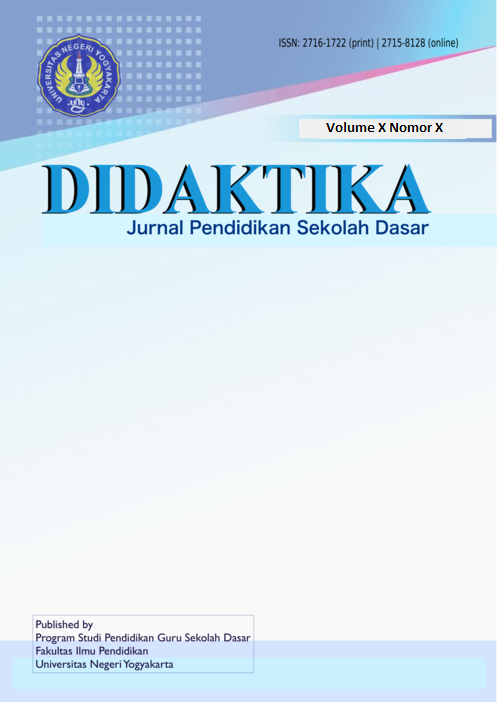Analysis of 4C's Ability in the Implementation of Online Learning in Elementary Schools
DOI:
https://doi.org/10.21831/didaktika.v5i1.45301Abstract
The goal of this study was to describe the 4 C's ability to implement the 2020/2021 odd semester learning at Jitu State Elementary School in Sidoarjo Regency. The research location, which is included in the countryside, is intended to obtain a qualitative picture of the ability of the 4 C's in elementary schools, most of which are rural. Qualitative research with a descriptive narrative research design is applied. The result is that during this pandemic, there is a reality that online learning does not allow the realization of the collaborative abilities of all classes. Critical thinking skills, creative thinking, and communication are planned and implemented in learning. The ability of students who study under the guidance of their parents at home decreases compared to face-to-face learning. The teacher marks the existence of student work that parents do. Individual learning causes a decline in students' critical thinking, creative thinking, and verbal communicative skills, although the three skills (creative thinking, critical thinking, and communication) are still visible in students. The impact of learning with individual assignments on students shows a significant decrease in the 4 C's ability.
Keywords: 4 C's, learning, critical thinking, creative thinking, elementary school
==================================================
Tujuan dari penelitian ini adalah mendeskripsikan kemampuan 4 C's dalam pelaksanaan pembelajaran semester ganjil 2020/2021 Sekolah Dasar Negeri Jitu Kabupaten Sidoarjo. Lokasi penelitian yang termasuk pedesaan dimaksudkan agar diperoleh gambaran kualitatif dari kemampuan 4 C's di Sekolah Dasar yang mayoritas ada di daerah pedesaan. Penelitian kualitatif dengan desain penelitian naratif deskriptif diterapkan. Hasilnya pada masa pandemic ini ada realita bahwa pembelajaran dalam jaringan tidak memungkinkan diwujudkannya aspek kemampuan kolaboratif semua kelas. Aspek kemampuan berpikir kritis, berpikir kreatif, dan komunikasi terencana dan terlaksana dalam pembelajaran. Kemampuan siswa yang belajar dibimbing orangtua di rumah menurun dibanding saat pembelajaran tatap muka. Guru menandai adanya pekerjaan siswa yang dikerjakan orangtua. Pembelajaran individual menyebabkan menurunnya keterampilan berpikir kritis, keterampilan berpikir kreatif, dan keterampilan komunikatif verbal siswa, walaupun ketiga keterampilan (berpikir kreatif, berpikir kritis, komunikasi) masih terlihat pada diri siswa. Dampak pembelajaran dengan penugasan individual pada diri siswa menampakkan penurunan kemampuan 4 C's sigifikan.
Kata kunci: 4 C's, learning, critical thinking, creative thinking, sekolah dasar
References
Arends, R. I. (2015). Learning to Teach 10th eds. USA: Mc Graw Hill.
Azhari, A., & Somakim, S. (2014). Peningkatan kemampuan berpikir kreatif matematik siswa melalui pendekatan konstruktivisme di kelas VII sekolah menengah pertama (SMP) negeri 2 Banyuasin III. Jurnal Pendidikan Matematika, 8(1), 1–12.
Chiruguru, S. B., & Chiruguru, S. (2020). The essential skills of 21st century classroom (4Cs). Shingania University Https://Www. Researchgate. Net/Publication/340066140_The_Essential_Skills_of_21st_Century _Classroom_4Cs.
Hammond, L. D., Hyler, M. E., & Gardner, M. (2017). Effective Teacher Professional Development. Retrieved November 10, 2019.
Haryanto, R. (2019). Tranformasi Pendidikan Abad 21 Melalui Rumah Belajar. Tersedia Di Http://Pena. Belajar. Kemdikbud. Go. Id/2019/07/Tranformasi-Pendidikan-Abad-21-Melalui-Rumah-Belajar/. Diakses Pada, 30.
Joynes, C., Rossignoli, S., & Amonoo-Kuofi, E. F. (2019). 21st Century Skills: evidence of issues in definition, demand and delivery for development contexts.
Kivunja, C. (2015). Exploring the pedagogical meaning and implications of the 4Cs" super skills" for the 21st century through Bruner's 5E lenses of knowledge construction to improve pedagogies of the new learning paradigm. Creative Education.
NEA. (2019, Desember 7). National Education Association.2010.Preparing 21st century students for a global society: An educators guide to the
Paniagua, A., & Istance, D. (2018). Teachers as designers of learning environments. Educational Research and Innovation, OECD: Paris, France.
Pribadi, B. A. (2018). Model Desain Sistem Pembelajaran. Jakarta : Penerbit Dian Rakyat.
Satori, D., & Komariah, A. (2014). Metodologi Penelitian Pendidikan. Jakarta: Bumi Aksara.
Sloane, P. (2017). The leader's guide to lateral thinking skills: unlock the creativity and innovation in you and your team. Kogan Page Publishers.
Sugiyono, P. D. (2015). Metode penelitian dan pengembangan. Res. Dev. D, 2015, 39–41.
Suhartono, S., Murti, T., & Artikasari, A. (2017). Keefektifan Model Pembelajaran Pilihan Aktivitas Belajar (Pab) Dalam Pembelajaran Tematik di Kelas IV SD. Sekolah Dasar: Kajian Teori Dan Praktik Pendidikan, 26(2), 182–192.
Sutanto, P. (2017). Panduan implementasi kecakapan abad 21 Kurikulum 2013 di SMA. Kementerian Pendidikan Dan Kebudayaan.
Zubaidah, S. (2018). Mengenal 4C: Learning and innovation skills untuk menghadapi era revolusi industri 4.0. 2nd Science Education National Conference, 13, 1–18.
Downloads
Published
How to Cite
Issue
Section
Citation Check
License
- Authors retain copyright and grant the journal right of first publication with the work simultaneously licensed under a Creative Commons Attribution License that allows others to share the work with an acknowledgement of the work's authorship and initial publication in this journal.
- Authors are able to enter into separate, additional contractual arrangements for the non-exclusive distribution of the journal's published version of the work (e.g., post it to an institutional repository or publish it in a book), with an acknowledgement of its initial publication in this journal.
- Authors are permitted and encouraged to post their work online (e.g., in institutional repositories or on their website) prior to and during the submission process, as it can lead to productive exchanges, as well as earlier and greater citation of published work.






